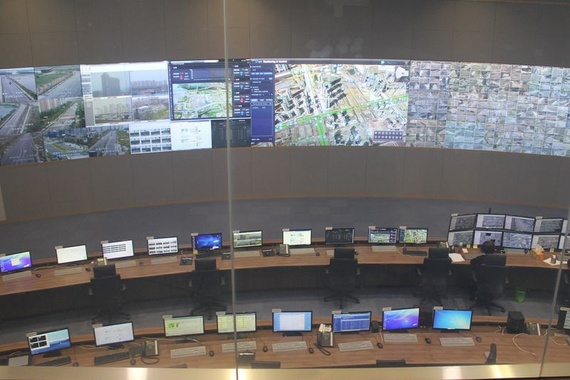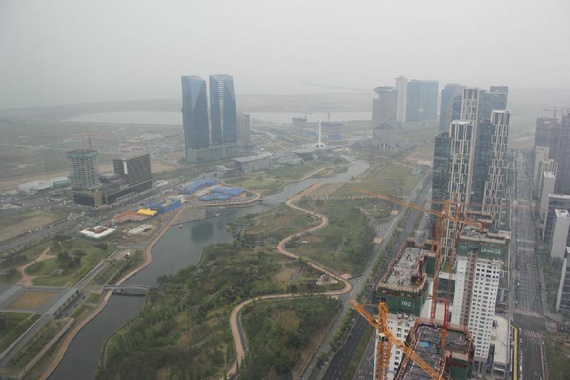In South Korea's "Smart City" of Songdo, Children are Tracked by Microchip and the Government Monitors CCTV Cameras Located Throughout the City

At Songdo’s U-Life Center, a wall of screens streams real-time footage from the CCTV cameras located throughout Songdo, so that "government officials can monitor traffic and spot crime." (Ross Arbes)
Songdo, South Korea: City of the Future?
Gale International, holds a majority stake of 61%, Posco 30%, and the remaining 9% is owned by Morgan Stanley Real Estate. The plan was designed by the New York office of Kohn Pedersen Fox (KPF). Infrastructure development, labor, and funding are also being provided by the city of Incheon.September 27, 2014
The Atlantic - Some of the developers of Songdo (which means “island of pine trees”) call it “The City of the Future.” Others have dubbed it “The World’s Smartest City” and “Korea’s High-Tech Utopia.” What, if anything, might such a city have in store for a tourist?
By the time we touched down at Incheon Airport in May, we knew Songdo’s short history. In 2000, it was still a marshy stretch of tidal flats in the Yellow Sea, home to a scattering of fishermen. Three years later, the Korean government filled it with 500 million tons of sand in an effort to build a business district near the international airport. (Seoul, the capital, is more than an hour away from the Incheon airport by bus; Songdo, an “aerotropolis” that boasts of being a short flight from one-third of the world’s population, is a mere 15-minute drive.) In addition to luring foreign business, the government hoped to create a sustainable city that demonstrated Korea’s technological prowess. Eleven years, $35 billion, and a few economic downturns later, Songdo has completed some 60 percent of its planned infrastructure and buildings, developers say, and reached a population of about 70,000—a third of the number expected by 2018, when the city will be “done.”

Songdo, from the 12th floor of the Sheraton Incheon (Ross Arbes)
Like most travelers, we spent our first night there in a hotel. Viewed from the 12th floor of the brand new, environmentally conscious Sheraton Incheon Hotel (the first LEED-certified hotel in South Korea), Songdo resembled an architect's model. Unlike the crowded and colorful streets of Seoul, the scene below was polished, spacious, sparse—not quite artificial, but not quite broken in yet either. It was more like the manifestation of a designer’s master plan than an evolved metropolis, with layers of lived-in depth. In the middle of the city—which, at 13,195 acres, is almost half the size of Boston proper—sat the 101-acre Central Park, where a few joggers enjoyed the morning sun. North of the park, a number of undulating, blue-glass skyscrapers towered over us. Beyond stood rows of plain concrete buildings and, farther still, large plots of dirt. Construction cranes swung in all directions.
Venturing into the busiest section of town for dinner, we struck up a conversation with an Australian pilot-trainer who spends two weeks a month in Songdo. “Is this the city of the future?” we asked. “I wouldn’t quite call it that,” he said. “Of course, this is a great place to be. And it’s unbelievable that it was all just a pile of sand 10 years ago.”
The city was built for a future that hasn’t yet arrived. Songdo’s wide sidewalks and roads—evoking a movie set—are still waiting for pedestrians and cars to fill them. (A number of music videos and television shows, most notably Psy’s “Gangnam Style,” have indeed been filmed in Songdo, taking advantage of its relative vacancy.) The quiet was almost eerie.

Songdo is connected by an underground system of pipes; garbage is sucked directly from people’s apartments into the “Third Zone Automated Waste Collection Plant,” where it is automatically processed. (Ross Arbes)
But this quiet lends itself to some nice surprises: You can hear birds, for instance. (Try that in Seoul.) An impressive 40 percent of the city will be park space—one of the highest percentages in the world, in keeping with Songdo's design as a green city. (New York City, by comparison, leads the United States with almost 20 percent green space.) There are bicycles everywhere: A significant portion of the residents are bike commuters, and they park their rides in long neat rows in front of their apartment buildings at night. There are lovely pedestrian thoroughfares flanking clothing boutiques and restaurants with outdoor seating. There are even small plots of land for urban farming, many of which were given to Songdo's former fishermen as reparation for the destruction of their fisheries. (Some now subsist as farmers.) Squinting at the green space, you could almost mistake the city for Portland, Oregon. Almost.
One morning, we found ourselves at Songdo’s waste-management center—the “Third Zone Automated Waste Collection Plant”—where we watched a video about the city’s garbage-removal system. Narrated like a Hollywood blockbuster, it explained that all of Songdo’s trash is sucked into underground pipes, and is automatically sorted and recycled, buried, or burned for fuel. These pipes connect all apartment buildings and offices; consequently, there are no street-corner trash cans or garbage trucks. Among the first of its kind in the world, the system currently requires just seven employees for the entire city.
Next, at a nearby office building, we learned about Songdo’s so-called “telepresence” system, which is currently being tested by 100 of the city’s residents. A joint venture by Cisco and the developers of the city, the system allows Songdo residents to sit in front of custom television screens and chat with English tutors in Hawaii or take fitness classes from instructors elsewhere in Korea. While the video-chatting technology itself was familiar to us—it's not a great leap from Skype—its integration into televisions and the subscription-oriented menu of classes was something we had not seen. (The system will be rolled out to 3,000 residents by year’s end, as well as some hotels.)
Finally, we visited Cisco’s Global Innovation Lab, where more technologies-in-development were on display, including mobile phone-controlled home appliances and even micro-chip tracking of Songdo’s children—so they don’t get lost. (Chips would be implanted in children's bracelets, bringing to mind a 1984-type future.) These and other technologies were being pitched to the Songdo government by Cisco, but had not been adopted yet, meaning that for the time being at least, the city’s children were free to sneak over to friend’s houses without fear of surveillance.
This was all pretty slick, but where were the levitating buildings and flying cars we had envisioned? The city’s futurism was incremental, as it turned out, coexisting with the familiar and mundane. We had expected a city 25 or even 50 years ahead of the rest of the world; instead, Songdo felt like 2017—still the future, perhaps, but not the promised land of science fiction. There were mostly just subtle, somewhat odd differences from the cities of the present—for example, in Central Park, a small island filled with rabbits, a cordoned-off section with captive deer, and the occasional hidden speaker playing relaxing classical music.
Walking around Songdo with a guide, we had passed a vacant exhibition hall with a large “Tomorrow City” sign in front. In 2009, the place had apparently showcased the future—such as it was imagined then. But it was closed in 2011, our guide said, “because our predictions have been realized. Tomorrow is yesterday.” The exhibition hall's windows were dark, and no one we spoke with remembered exactly what technologies were featured inside. Were we merely visiting yesterday’s tomorrow?

Is this the future? A cordoned-off section of Songdo’s 101-acre Central Park features captive deer in front of ultra-modern residential buildings. (Ross Arbes)
In any case, Songdo did not fail to offer us Luddite pleasures, like the serenity of a canoe gliding through the park’s saltwater canal. The clear blue water reflected the green trees on the banks, behind which stood the tallest building in South Korea. There, the city felt like the “breath of fresh air” that Richard Nemeth, one of its designers, explained they had intended it to be, in contrast to stiflingly dense Asian cities.
Songdo offers a host of familiar transit options—buses, subways, pedestrian thoroughfares—but, on our last day, we chose the one most popular among its residents: bicycling. Pedaling the island’s 20 miles of paths, past the popular NC Cube outdoor shopping mall, past the tennis courts in the shadow of the Incheon bridge, past modest residential buildings on the outskirts of town, past the international campuses of the University of Utah and George Mason University, past fences covered in red roses, biotech labs, empty plots, half-completed buildings, and even a purveyor of Dippin' Dots ("ice cream of the future"), we finally arrived at the lonely sea wall where this unlikely and incomplete city began.



M240DAD 338
ReplyDeleteLooks good, but where are the farmers? Who's growing the food? You can't eat software.
Michael Angel
True, but you can have darker people to grow rice and pay them with software-earned money.
·
Nick Jones
It's the 21st century, you can import food. Also it is better for countries to produce high-end products like software and machinery than primary products like cabbage and potatoes. This is why South Korea is a rich country. But at the same time, you still have to maintain some form of farming industry, just in case, but I doubt South Korea could feed itself, unless everyone goes back to farming (poor).
·
M240DAD 338
Farmers of the coming near future will be the winners. The cities will be insane asylums run by the inmates.
https://www.youtube.com/watch?v=2LN5lmESc9k